I’ve seen this technique on several sites and I’ve noticed that people are having trouble replicating it. Some sources require that you locate and use bicarbonate of soda instead of baking soda because the former does not fizz up as much. They are the same thing people, Sodium bicarbonate. The reason I’ve found that separates success from fizzy failure is active vs. stale bicarbonate.
I am no chemist, but as far as I understand, baking soda that has been sitting around too long or has been kept in warm or damp places will lose its carbon dioxide making it closer to sodium carbonate or washing soda/soda ash. The trick to this technique is you need stale baking soda.
When I first tried this basing technique, I was fortunate enough to have an old box of Arm & Hammer (A&H) sitting in my pantry. It had been used once, but I have no clue how long it had dwelled there awaiting its true calling.
I will experiment with this method using a fresh box of A&H vs. a box that I’ve staled and post it as an addendum to this tutorial. I need to make sure I know what I’m talking about because we all know that there be R-Tards out there scouring the interwebs for ill-informed articles to correct. So stay tuned.
Anyway, here’s a rundown on making your bases appear like your army marches through a land gripped by a harsh winter. It’s really quite easy.
Here’s what you’ll need:
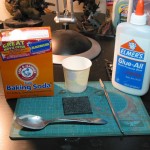
- Small mixing cup (a box of Dixie Cups would be perfect)
- Sculpting tool
- White PVA glue
- Baking Soda
- Teaspoon
- Shallow plastic container
- Soft bristled paint brush
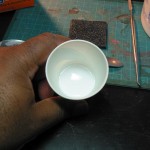
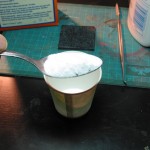
Step I: Squirt a measure of PVA ( I used white Elmer’s Glue All) into your mixing cup. I filled the bottom of my Dixie cup about 1/4th of an inch.
Step II: Grab your teaspoon and add a spoonful of baking soda to your glue.
Step III: Grab your sculpting tool and stir. It will ball up on the side of your cup at first but as the soda becomes saturated with PVA it will settle down on the bottom of the cup like a thick paste.
Add PVA till you get a smooth thick paste with stiff peaks. You will know you have the right mixture when the paste turns damp and shiny when allowed to settle. This quality is required for Step V so be sure it’s mixed well.
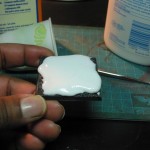
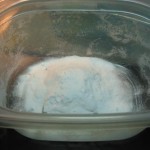
Step IV: With the flat end of your sculpting tool scoop your paste onto the base and a position it as you see fit. If it was made to the right consistency it will level out some but won’t spread off your base.
Step V: This is the most important step! Place your base into the shallow container and cover it with several heaping teaspoons of baking soda. Make sure the entire base is covered. Set your container aside and let it dry.
You need to allow the PVA plenty of time to dry before moving on to the final step. I don’t handle my bases for at least 5 hours to allow complete drying time. That may seem like overkill but trust me, if you move onto the next step with the PVA still damp you are going to be royally pissed off when it does dry. The damp quality needed in Step III is what makes this technique look so cool when it’s done. As the PVA dries it absorbs more soda onto its surface. This process continues until the glue is completely dried. Removing the excess soda while the PVA is still moist can cause the base to cure with a glossy texture and your base will appear to be covered in white slime. So set them up and go to bed, visit some friends, knit a quilt, anything just leave the damn bases alone.
Step VI: Knock off the excess soda into your drying container and dust off the remaining soda with your brush. And you’re done! The soda even sparkles in light like real fresh snow. Pretty damn cool eh? You can still use that soda from your drying box so don’t discard it!
A model’s base is the one part that can make or break a project. I’ve seen many great minis ruined by a sub-par base, and just as many average paint jobs elevated by an excellent display base. Try to put as much thought into your basing as you do your project and you really can’t go wrong.
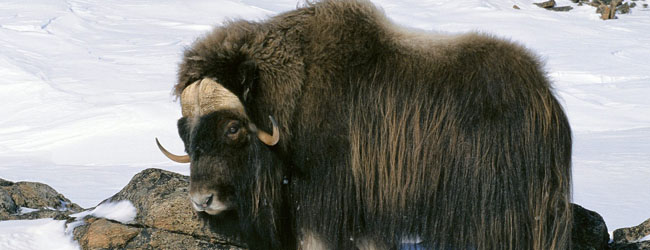
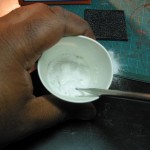
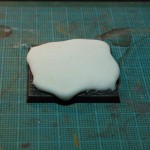
hi. love your blogg and tutorials here! 🙂
probably completely newbie questions; how does the snow react to varnish? and how would you go about positioning your figures in it, if you make more or less completely snow covered bases? (like position them in while the “snow” is drying, so they will be sunken into the snow a bit, or is there some other good way of doing it?)
thanks in advance, and keep up the good work, really appreciated! 😀